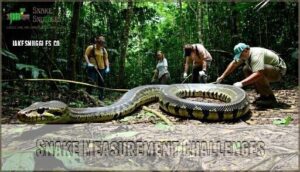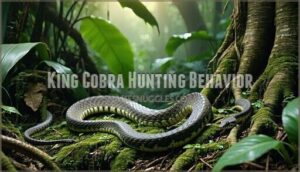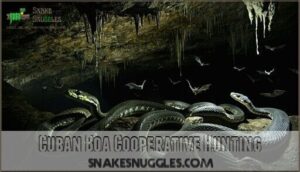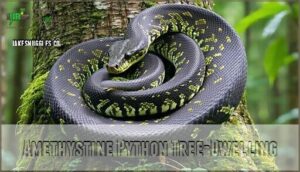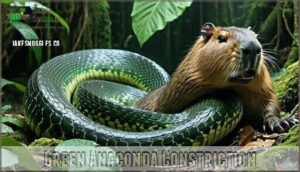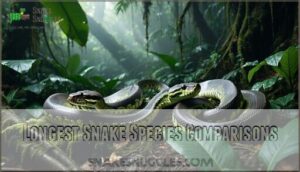This site is supported by our readers. We may earn a commission, at no cost to you, if you purchase through links.
 When exploring large snake species profiles, you’ll encounter nature’s most impressive serpentine giants.
When exploring large snake species profiles, you’ll encounter nature’s most impressive serpentine giants.
The green anaconda reigns as the heavyweight champion at 550+ pounds, while reticulated pythons claim the length title, stretching beyond 30 feet.
These apex predators showcase incredible diversity—from South America’s semi-aquatic anacondas to Southeast Asia’s tree-dwelling pythons.
Each species has evolved unique hunting strategies and physical adaptations that’ll blow your mind, including venomous firepower from king cobras and bone-crushing power from constrictors like Burmese pythons.
Measuring these elusive giants presents fascinating challenges that researchers are still working to solve, highlighting the incredible diversity of these species.
Table Of Contents
Key Takeaways
- You’ll discover that measuring these giants accurately presents major challenges – dead snakes stretch 10-20% longer than living ones, shed skins can be twice the actual length, and wild measurements average 4cm error due to handling difficulties.
- You’ll find clear size champions among species: green anacondas reign as heavyweights at 550+ pounds, reticulated pythons claim length records exceeding 30 feet, while each species has evolved unique hunting adaptations from aquatic ambush to arboreal precision.
- You’ll encounter remarkable behavioral diversity beyond size – king cobras build elaborate leaf nests and pack elephant-dropping venom, Cuban boas demonstrate cooperative hunting teamwork, and African rock pythons show aggressive defensive patterns that set them apart.
- You’ll see how habitat determines survival strategies, with reticulated pythons mastering ambush tactics in dense vegetation, scrub pythons dominating forest canopies, and invasive Burmese pythons devastating Florida’s ecosystem through their adaptability.
Largest Snake Species
You’ll encounter some of the planet’s most impressive serpents when exploring the world’s largest snake species, from the massive Green Anaconda weighing up to 551 pounds to the record-breaking Reticulated Python stretching over 32 feet long.
These giants showcase nature’s incredible diversity through their unique habitats, hunting strategies, and the remarkable challenges they present to researchers attempting to measure their true sizes, highlighting the incredible diversity of these species.
Green Anaconda Characteristics
You’ll find the Green Anaconda reigning as the heavyweight champion of giant snakes, tipping scales at over 550 pounds.
These Anaconda species dominate Swamp Ecology through their massive girth and ambush prowess, making them nature’s ultimate aquatic predators in South America’s wetlands.
- Size dominance: Females dwarf males, reaching 29+ feet in Anaconda Habitat while males max out at 10 feet
- Snake Constriction mastery: Crushes prey through suffocation, not bone-breaking like Hollywood suggests
- Anaconda Diet variety: Devours capybaras, caimans, deer, and even jaguars when opportunity strikes
- Aquatic adaptations: Eyes and nostrils positioned topside for seamless underwater ambush attacks
- Reproductive powerhouse: Births 20-40 live young after seven-month gestation in breeding ball competitions
The Green Anaconda’s massive size is due to its slow metabolism issues that allow it to survive for weeks without eating.
Reticulated Python Habitat
You’ll discover Reticulated Pythons thriving across Southeast Asia’s diverse landscapes, from dense rainforest ecology to bustling urban environments.
These adaptable giants navigate forest floors and wetland habitats with equal prowess.
Their remarkable urban adaptation allows them to flourish in cities, parks, and agricultural areas, making them the ultimate survivors among large snake species due to their python habitat flexibility.
Burmese Python Invasive Species
Between 30,000 and 300,000 Burmese Python individuals now dominate Florida’s Everglades, creating massive Habitat Destruction since their official recognition in 2000.
These invasive species originated from pet trade releases and Hurricane Andrew escapes, triggering devastating Species Interaction changes.
Their Everglades Impact includes 90-99% native mammal population crashes, despite intensive Conservation Efforts removing over 20 tons of large reptiles.
These snake species profiles reveal detection rates remain discouragingly low at just 1%, and the public can learn more about the invasive snake species and their effects on the ecosystem.
African Rock Python Distribution
You’ll encounter African Rock Python populations spanning the vast Sub-Saharan Range, from Senegal to Somalia and down to South Africa.
These large reptiles dominate savannah ecology, thriving in grasslands, forests, and areas near water sources.
However, habitat loss increasingly fragments their geographic isolation, forcing snake species into smaller territories.
Conservation efforts target protecting remaining snake habitats where these impressive snake distribution patterns can flourish naturally, focusing on conservation efforts.
Snake Measurement Challenges
You’ll face unique challenges when trying to measure these massive serpents accurately in their natural habitats.
Measuring wild giants requires skill, patience, and a healthy respect for nature’s most elusive predators.
Dead specimens often stretch longer than living ones due to muscle relaxation, while shed skins can mislead researchers by extending up to twice the snake’s actual body length, which can be attributed to the snake’s actual body length being different.
Measuring Wild Snakes
Measuring wild snake length presents unique field challenges that’ll test your skills.
You’ll need tube-restraint or noose-stretch methods for accurate snake size readings. Wild measurements average 4cm error due to snake handling difficulties and movement.
Field methods require flexible tape following body contours, with experienced handlers achieving better precision. Restraining behind the head minimizes defensive responses.
Measurement tools must accommodate uncooperative subjects and environmental factors affecting snake length records. Accurate snake measurements rely on proper snake measuring tools to guarantee reliable data.
Dead Snake Measurements
Dead snakes pose unique measurement challenges you’ll encounter in research settings.
Post mortem muscle relaxation causes snake stretching, making specimens appear 10-20% longer than living counterparts.
Decomposition effects further complicate accurate snake size documentation, as tissues lose structural integrity.
These measurement errors substantially impact snake length and snake weight records, creating inflated data about the largest snakes worldwide.
Accurate identification of dead snakes requires understanding death signs clearly, which is critical for maintaining data integrity and avoiding inaccurate records.
Shed Skin Reliability
You’ll quickly discover that snake shedding creates unreliable measurement data—shed skin can stretch up to twice the snake’s actual length.
This skin stretch leads to massive measurement errors when researchers rely on molted scales. Snake molting frequency varies by species, making molt patterns inconsistent for size verification.
During skin regeneration, the discarded material becomes elastic and misleading. Smart snake ecology studies now avoid using snake skin for length assessments.
Accurate snake length measurements require specialized snake measuring tools to guarantee reliable data, ensuring reliable data collection.
Captive Snake Growth
You’ll find that captive snakes often outgrow their wild counterparts due to consistent feeding habits and ideal habitat simulation.
Snake enclosures provide controlled environments where growth rates accelerate beyond natural limits.
This affects snake size comparison studies, as captive breeding programs produce specimens that skew snake weight comparison data.
When evaluating snake species records, you must distinguish between wild-caught and captive-raised individuals for accurate assessments to ensure a fair comparison of snake size.
Venomous Snake Profiles
You’ll discover that venomous giants like the King Cobra pack enough neurotoxic punch to drop an elephant, while their hunting strategies reveal surprising cooperative behaviors.
These apex predators combine deadly efficiency with remarkable nesting instincts that’ll change how you think about snake intelligence.
King Cobra Venom
When you’re dealing with King Cobra venom, you’re facing one of nature’s most potent cocktails.
This lethal cocktail can drop an elephant with a single bite—nature’s most terrifying neurotoxic masterpiece.
This lethal mixture delivers a knockout punch that can drop an elephant.
- Venom Composition: Contains 43-64% three-finger toxins and 12-24% metalloproteinases
- Snake Bites: Single bite yields 400-600mg of venom – enough for twenty humans
- Toxic Effects: Causes rapid paralysis within 30 minutes through neuromuscular blockade
- Antivenom: Only Thailand produces species-specific treatment; prompt administration saves lives
- Venom Delivery: Geographic variation affects snake venom toxicity and antivenom effectiveness
King Cobra Hunting Behavior
You’ll witness the King Cobra’s remarkable hunting prowess through its calculated approach to prey immobilization.
This apex predator employs sophisticated hunting strategies, using snake camouflage to remain virtually invisible while stalking other snakes.
Its venom delivery system creates devastating neurotoxic effects that quickly subdue even large pythons and fellow venomous snakes.
| Hunting Aspect | Method | Target Effect |
|---|---|---|
| Prey Selection | Targets other snakes primarily | Ophiophagy (snake-eating) specialist |
| Approach Tactics | Stealth and ambush techniques | Surprise attack advantage |
| Venom Application | Single precise bite delivery | Rapid nervous system shutdown |
| Prey Handling | Swallows prey whole headfirst | Efficient consumption process |
| Success Rate | High due to specialized hunting | Dominates snake predator hierarchy |
King Cobra Nesting Habits
You’ll discover that King Cobra nesting habits showcase remarkable maternal instincts among snake species.
These venomous giants construct elaborate leaf nests, demonstrating unique reptile conservation behaviors that set Ophiophagus hannah apart from other serpents.
King Cobra nest building involves:
- Nest Building – Females gather leaves and vegetation into multi-chambered structures
- Egg Incubation – Temperature regulation through decomposing organic matter for 60-90 days
- Hatchling Care – Mothers guard eggs until babies emerge, then abandon the nest
- Nest Defense – Aggressive protection against predators during the vulnerable incubation period
Cuban Boa Cooperative Hunting
You’ll witness nature’s most remarkable teamwork when Cuban boas organize cooperative hunting expeditions along cave ceilings.
These large snakes form strategic "fences" to capture fruit bats, demonstrating unique group behavior among boa constrictors.
This hunting strategy makes them the only land-based snake species known for such sophisticated prey capture techniques and snake sociality.
Understanding boa constrictor laws is essential for responsible ownership and conservation of these species, showcasing their complex hunting strategy.
Non-Venomous Snake Profiles
When you’re exploring the world’s largest non-venomous snakes, you’ll discover fascinating predators that rely on sheer power rather than toxic bites.
These massive constrictors have evolved remarkable hunting strategies and adaptations that make them some of nature’s most impressive apex predators.
Amethystine Python Tree-Dwelling
You’ll spot these massive Amethystine Python specimens mastering Tree Climbing techniques throughout Indonesia’s dense Forest Habitat.
Their incredible Snake Camouflage lets them blend seamlessly with bark patterns while executing Arboreal Hunting strategies.
These tree-dwelling snakes showcase remarkable Python Behavior, spiraling up trunks with muscular precision.
Among large snakes, their arboreal habits make them formidable ambush predators in canopy environments.
Reticulated Python Ambush Tactics
When you’re tracking reticulated pythons in dense vegetation, you’ll discover their ambush strategies rely on exceptional camouflage methods and lightning-fast attack patterns.
These constrictors use distinctive net-like patterns for perfect concealment while employing heat-sensing pits to detect prey.
Their hunting techniques involve remaining motionless near game trails, then striking within 1/20th of a second—making them incredibly efficient ambush predators.
Understanding proper snake handling techniques is essential for safely interacting with these animals.
Green Anaconda Constriction
You’ll witness nature’s ultimate grip when Green Anaconda constrictors employ their lethal constriction methods.
These massive snake anatomy powerhouses don’t just squeeze—they’re precision killers.
Each coil tightens with your heartbeat, cutting off blood flow to essential organs.
Large anacondas use calculated hunting tactics, wrapping around Anaconda Prey like capybaras with surgical accuracy.
Snake constriction here surpasses typical boa constrictor pressure, creating wild encounters that end swiftly through suffocation.
Indian Python Cultural Significance
Beyond raw power, the Indian Python carries deep cultural symbolism throughout South Asian societies.
You’ll find these magnificent serpents woven into Indian folklore as divine protectors and symbols of fertility.
Snake worship traditions honor pythons in temple ceremonies, while mythical stories portray them as guardians of hidden treasures.
Traditional practices include ritual feeding and protection of these creatures, reflecting their profound cultural importance in python snake reverence across generations.
Longest Snake Species Comparisons
You’ll discover how the world’s longest snakes stack up against each other through precise measurements and verified records.
We’ll compare the reticulated python’s impressive length achievements with the green anaconda’s heavyweight championship and examine what makes each species uniquely suited to claim their spot among nature’s most impressive serpents, including their ability to achieve heavyweight status.
Reticulated Python Length Records
You’ll find the reticulated python holds undisputed dominance in snake length records. Medusa, housed in Kansas City, stretches an impressive 25.2 feet—officially verified through rigorous measurement protocols.
Wild specimens rarely exceed 21 feet, though captive environments foster extraordinary Python Growth potential.
| Record Category | Length (feet) |
|---|---|
| Captive Record (Medusa) | 25.2 |
| Average Wild Adult | 16-21 |
| Disputed Historical Claim | 32.8 |
Snake Measurement challenges persist with Length Variations between wild and captive populations. Record Breakers like Medusa demonstrate how controlled feeding transforms these largest snakes into true giants, making reticulated python the undisputed champion among longest snakes worldwide.
The study of python products and python care tips is essential for understanding their growth and behavior.
Green Anaconda Weight Records
While reticulated pythons claim length records, Green Anaconda weight records truly showcase nature’s heavyweight champions.
You’re witnessing anaconda species that defy imagination with their massive bulk and record weights.
| Record Category | Weight Achievement |
|---|---|
| Largest Verified | Ana Julia: 440 pounds (2024) |
| Museum Maximum | 215 pounds (wild specimen) |
| Captive Record | 200 pounds at death |
| Disputed Claims | Up to 1,100 pounds |
These snake mass measurements reveal how anaconda feeding patterns directly influence their incredible size potential among the largest snakes worldwide.
African Rock Python Aggressive Nature
While anacondas dominate by weight, you’ll find African Rock Python aggressive nature sets them apart through their defensive mechanisms and threat response patterns.
Their snake behavior includes pronounced defensive strikes when cornered, making these constrictors particularly challenging to handle compared to other large species.
| Behavioral Aspect | African Rock Python Response |
|---|---|
| Attack Patterns | Quick defensive strikes with recurved teeth |
| Hunting Strategies | Ambush predation with cooperative behaviors |
| Aggressive Behavior | Heightened during breeding and territorial disputes |
| Snake Ecology Role | Apex predator with strong constriction abilities |
Their aggressive nature stems from survival instincts rather than malice, with most documented attacks occurring during defensive situations or habitat encroachment conflicts.
Scrub Python Arboreal Habitat
You’ll discover that Scrub Python arboreal habits make them nature’s ultimate climbers.
These Australian scrub python masters navigate forest canopy with impressive skill, using powerful muscles for branch hunting. Their rock dwelling nature combines with tree climbing abilities, creating versatile predators who dominate both vertical terrains and leaf litter below.
| Habitat Feature | Scrub Python Adaptation |
|---|---|
| Forest Canopy | Strong grip, muscular coils |
| Rocky Outcrops | Flexible body, secure anchoring |
| Branch Systems | Ambush positioning, patient hunting |
These Amethystine python relatives showcase how snake habitats extend beyond ground level, proving that mastery comes from adapting to every available niche in their environment.
Frequently Asked Questions (FAQs)
What is the largest specie of snakes?
Weighing up to 551 pounds, you’ll find the Green Anaconda claims the title as the world’s largest snake species by mass.
The Reticulated Python holds the record for length at 32 feet, which is a notable record for snake species.
What is the name of the largest snake in history?
You’re looking at Titanoboa cerrejonensis, the undisputed heavyweight champion of snake history! This prehistoric monster stretched nearly 50 feet long and weighed over 2,500 pounds, making today’s anacondas look like garden snakes.
Is there a 30 foot snake?
Yes, you’ll find green anacondas reaching up to 30 feet in South American swamps. These heavyweight champions dominate their aquatic territories, proving that nature’s giants still roam our planet today.
How do snakes mate and reproduce?
Snakes reproduce through internal fertilization, with males using specialized organs called hemipenes. You’ll find females lay eggs or give birth to live young depending on species.
What do baby snakes eat first?
Baby snakes typically eat their first meal within days of hatching, consuming small prey like insects, worms, or tiny rodents that match their mouth size and hunting abilities.
How long do large snakes live?
Time’s river flows differently for these serpentine giants.
You’ll find large snakes living 20-30 years in captivity, with reticulated pythons reaching 25 years and green anacondas hitting 30 years when properly cared for.
Can snakes swim in saltwater effectively?
Most large snakes can’t effectively swim in saltwater – they’re freshwater specialists. However, sea snakes dominate ocean environments, while some species like anacondas tolerate brackish water occasionally.
Do large snakes have natural predators?
Ironically, while you’d think massive predators would rule unchallenged, large snakes do face threats.
Jaguars, crocodiles, and birds of prey target juveniles, while humans remain their biggest enemy through habitat destruction and hunting, which is a significant threat due to habitat destruction.
Conclusion
Remarkably, you’ve discovered that nature’s timing coincides perfectly with our modern fascination for these record-breaking serpents.
While you’re studying large snake species profiles, you’ll find that each species represents millions of years of evolutionary perfection.
These giants aren’t just impressive statistics—they’re living proof that size, strength, and adaptability can coexist in remarkable ways.
Understanding their unique characteristics helps you appreciate why these incredible creatures continue fascinating researchers and enthusiasts worldwide, and it’s a testament to their ability to thrive, making them a subject of endless fascination.
- https://en.wikipedia.org/wiki/List_of_largest_snakes
- https://www.ultimatekilimanjaro.com/10-biggest-snakes-in-the-world/
- https://www.nationalgeographic.com/animals/reptiles/facts/green-anaconda
- https://www.nhm.ac.uk/discover/what-is-the-biggest-snake-in-the-world.html
- https://a-z-animals.com/blog/python-size-comparison-just-how-big-do-the-different-types-get/

